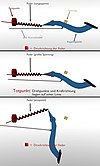Dead center
In mechanics, one speaks of dead center when the connecting joints and the force vectors acting on a flat lever mechanism lie on a common straight line.
The applied force is only transmitted to the stopping point of the mechanism, the lever cannot be moved without external influence. Only a force across the main axis of this mechanism changes this state. This position is important when designing and using rotary and sliding joint drives. Reaching a dead center is undesirable or tolerated. But there are also applications (for example toggle levers ) that make use of the dead center.
Crank drive
The dead center position of a crankshaft drive is given when the 3 axes of rotation of the crankshaft axis and the connecting rod bearing axis ( connecting rod, connecting rod) and the piston pin or crosshead axis lie in one plane. A distinction is made between top dead center (TDC) , where the drive rod (piston, cross head) is at the greatest distance from the crankshaft, and bottom dead center (BDC) , where the drive rod is the smallest distance from the crankshaft. Since the drive rod force is completely absorbed by the axle bearings at these positions and without developing any lateral components, the crank drive cannot start from both positions without assistance.
Internal combustion engine
As dead center is referred to the positions of the crankshaft of an internal combustion engine in which the piston movement does not execute more in the axial direction.
The location of the dead centers is clearly determined by the geometry of the crankshaft, connecting rod and piston.
In four-stroke engines, a distinction is also made between gas exchange TDC (LWOT, between exhaust and intake stroke) and ignition TDC (TDC, between compression and power stroke).
The top dead center serves as a reference for the crankshaft position. The ignition point in gasoline engines and the start of injection in diesel engines are given in degrees before TDC.
In the rotary piston engine , dead center positions mean the positions of the rotary piston in which the chamber volume is minimal or maximal. With a rotor position of 30 ° (corresponds to an eccentric angle of 90 °), the smallest chamber volume (TDC) occurs, and with a rotor position of 60 ° (corresponds to an eccentric angle of 180 °), the largest chamber volume (BDC).
Electric motor with double T armature
If the rotor ( double T armature ) of an electric motor is located exactly between the north and south poles of the stator, the commutator ensures that no current flows through the coil of the rotor at this moment. Such a motor does not start from this position. The momentum from a previous rotational movement ensures that this dead center is overcome.
Dead center spring
The dead center spring, also known as the over dead center spring, is a simple form of utilizing a dead center. A pretensioned spring is attached to a lever in a slightly offset position to the pivot point. If the dead center is overcome when moving the lever, the spring relaxes in the actuating direction. Thus, the force required to operate is greatest at the beginning of the lever path and then becomes smaller. This technology is often used, for example, as a coupling aid , as an opening aid for doors (car tailgate, dishwasher door) or in electrical switches (toggle switches).
pendant
When reversing with a trailer, the dead center is used. The driver of the towing vehicle must maneuver in the area of the dead center in order to be able to drive straight backwards. If he steers too far away from it, the trailer buckles and drives around the bend.
literature
- Hans-Hermann Braess, Ulrich Seiffert: Vieweg manual automotive technology. 2nd edition, Friedrich Vieweg & Sohn Verlagsgesellschaft mbH, Braunschweig / Wiesbaden, 2001, ISBN 3-528-13114-4 .
